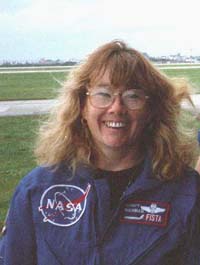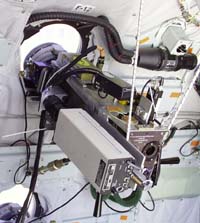|
Leonid MAC |
| home |
| View the shower |
| Mission Brief |
| Science Update |
| Media Brief |
| links |
 Sandra Nierman,
Sandra Nierman, Air Force Research Laboratory 
Last updated: October 2001
Brief Biographical Information: Sandy Nierman is a staff researcher at the Air Force Research Laboratory. Research: During the 1999 Leonid multi-aircraft campaign, Sandy Nierman worked with the AFRL and SRL research teams to operate three instruments: 2 Michelson interferometers and one infrared imager. The two interferometers cover the 1 - 3 micrometer band of the spectrum. These instruments will be tracked onto the persistent meteor trains to try and spectrally measure the emission in this band, which should help identify the radiating species and give insight into exactly what is happening in a persistent train. Each interferometer has a co-aligned low light level sensor so that the small field of view of the interferometer can be directed onto the persistent train. Results included the detection of an increase of OH emission at the peak of the meteor storm (more info here), and the first detection of meteors in the near-IR (unpublished data). Research on Leonid MAC: During the 2001 Leonid MAC mission, a Bomem spectrograph will be deployed in an effort to confirm the increase of OH coincident with the meteor storm. In addition, three mid-IR imagers will be deployed from FISTA with bandpass filters chosen to pick up the 3.4 um band, in tsearch for organic matter release. Our equipment continues to improve (our continuous digital recording software is much better than during Leonid 99). One innovation we have been developing (for reasons utterly unrelated to meteors) is the capability to record our IR imagery at extremely high data rates, providing potentially a VERY detailed time history of its spatial structure if a bright enough meteor passes its field of view.
|



